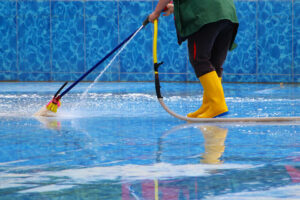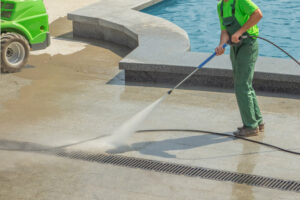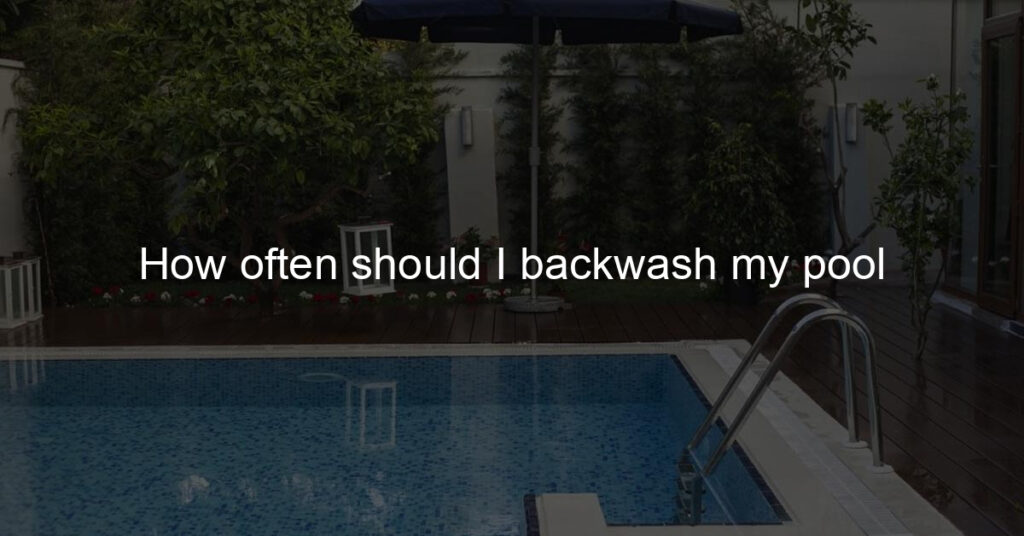How Often Should I Backwash My Pool
Imagine dipping your toe into a pristine, sparkling pool, only to realize that the water is murky and unclean—quite the summer buzzkill, isn’t it?
Maintaining your pool’s cleanliness is not merely about aesthetics; it also influences the health of those using it. Crucial to this upkeep is understanding the process of backwashing your pool. But how often should you really do it?
In this guide, we’ll demystify this question, discuss the factors that influence the frequency of backwashing, and even reveal some tricks to ensure you’re doing it at just the right time.
Dive in as we navigate the waves of pool maintenance together!
Understanding Pool Backwashing: What is it?
Backwashing is a vital pool maintenance process that involves reversing the flow of water through your pool filter to flush out debris and contaminants.
Whether you have a sand filter or a diatomaceous earth (DE) filter, backwashing works to cleanse the filter medium and optimize its performance.
Essentially, it’s like giving your pool filter a deep clean. When the water is redirected, it washes all the accumulated dirt and debris out through a waste line, leading to a more efficient filtration system and cleaner pool water.
The Importance of Regular Pool Backwashing

Regular backwashing of your pool is crucial to maintain clear and healthy water. Over time, your pool filter captures a considerable amount of debris, which can ultimately clog the system.
This not only reduces the effectiveness of the filtration system but can also lead to damage. By backwashing, you’re giving the pool filter a chance to offload this burden, allowing it to function better and last longer.
Plus, backwashing contributes to better water circulation and chemical distribution, which makes your pool safer and more enjoyable to swim in.
The Role of Your Pool’s Filter System
The pool filter plays a key role in keeping your pool water clean, clear, and healthy. It works continuously to remove impurities from the water—everything from leaves and grass to dust and bacteria.
The type of filter you have—whether it’s sand, cartridge, or diatomaceous earth—will dictate how you maintain it. Each filter type has a unique set of maintenance requirements and a specific way it should be backwashed.
Knowing your filter system’s particular needs is key to optimizing your backwashing routine.
Recognizing When It’s Time to Backwash Your Pool
Recognizing the right time to backwash your pool can be a bit of an art. One of the telltale signs is an increase in your filter’s pressure gauge reading.
Typically, when the reading is 8-10 PSI above the normal operating level, it’s a good indication that your pool could use a backwash. Another sign could be cloudy water or reduced water flow, both of which may indicate a clogged filter.
Remember, these are just guidelines, and actual needs may vary based on factors like pool usage, weather, and more.
The Typical Frequency of Pool Backwashing: A Rule of Thumb

As a rule of thumb, most pool experts recommend backwashing your pool every 4-6 weeks or whenever the pressure gauge reads 8-10 PSI over its normal operating level.
However, this is a general guideline and may vary depending on many factors. For instance, a frequently used pool may require more frequent backwashing, while a rarely used pool may need it less often.
The key is to keep a close eye on your pool’s clarity and filter pressure.
The Impact of Pool Usage on Backwash Frequency
How often your pool is used and how many people are using it can significantly impact the frequency of backwashing. More use means more debris—like body oils, sunscreen, hair, and even the dirt on a swimmer’s body—introduced into the pool, which in turn gets caught in the filter.
As such, a pool that sees heavy usage may require more frequent backwashing to maintain optimal water clarity and filter performance.
The Effect of Weather Conditions on Pool Backwashing
Weather conditions play a significant role in determining the frequency of backwashing. After heavy rains or windstorms, additional debris can end up in your pool, putting extra strain on the filter.
Likewise, during the hot summer months, evaporation can concentrate substances in the water, necessitating more frequent backwashing. It’s important to monitor the weather and adjust your backwashing schedule accordingly.
How the Size and Type of Your Pool Affects Backwashing Frequency

The size and type of your pool can influence how often you should backwash. Larger pools may require more frequent backwashing due to the greater volume of water and potentially higher debris levels.
Likewise, pools with a more complex shape or with features like waterfalls or fountains may have more areas where debris can accumulate, potentially necessitating more frequent backwashing.
The type of pool filter you have—sand, cartridge, or diatomaceous earth—also affects backwashing frequency, as each filter type has different maintenance needs.
The Influence of Your Surrounding Environment on Backwashing Needs
The environment surrounding your pool can also impact your backwashing needs.
For example, if your pool is surrounded by trees, you may find leaves and other organic debris falling into your pool more often.
Similarly, if your pool is in an open area where it’s exposed to wind, dust, and other airborne particles, your filter may get dirty faster. Thus, pools in such environments may require more frequent backwashing.
A Detailed Guide to the Pool Backwashing Process
Backwashing your pool might seem complex, but once you know the steps, it becomes a routine process.
First, you’ll need to turn off your pool pump. Next, move the multiport valve on your pool pump to the ‘backwash’ setting. Then, turn your pump back on. You should see dirty water coming out of your waste line. Once the water runs clear (usually after a few minutes), turn off the pump, move the valve to the ‘rinse’ setting, and turn the pump back on for another minute.
Finally, turn off the pump, return the valve to the ‘filter’ setting, and restart your pump. Remember, the process can vary slightly depending on your pool and filter setup.
Common Mistakes During Pool Backwashing and How to Avoid Them
Common mistakes during backwashing can compromise the effectiveness of the process.
For example, backwashing too frequently can be counterproductive, as a slightly dirty filter is often more efficient at trapping small particles than a completely clean one. Another mistake is not backwashing long enough for the water to run clear, or not rinsing after backwashing, which can result in loose debris returning to the pool.
Reading the manufacturer’s instructions and following recommended procedures can help avoid these common pitfalls.
Pool Backwashing: What Comes After?
After backwashing, it’s essential to monitor your pool water’s chemistry. Backwashing can sometimes disrupt the balance of chemicals in your pool, so you’ll need to test your pool water and adjust chemical levels as necessary. It’s also good to add a pool clarifier to your water post-backwash.
The clarifier can help your filter work more efficiently by clumping tiny particles together so the filter can catch them more easily.
Quick Tips to Streamline Your Backwashing Routine
Streamlining your backwashing routine can save you time and energy. For instance, using a pre-filter skimmer basket can help catch larger debris before it reaches the main filter, reducing the frequency of backwashing.
It’s a good idea to keep a written record of each backwash (including date, time, and any notable issues). This can help you understand your pool’s unique needs and anticipate when the next backwash may be needed.
Myths vs. Facts: Debunking Common Misconceptions About Pool Backwashing

There are many myths surrounding pool backwashing. For instance, some believe that it’s necessary to backwash every week, while others think it’s only needed once a season. The truth lies somewhere in the middle: the frequency of backwashing should be based on factors like pool usage, weather, and the surrounding environment.
Another misconception is that backwashing alone can keep a pool clean. In reality, backwashing is just one part of comprehensive pool maintenance, which should also include regular skimming, vacuuming, and chemical balancing.
Essential Pool Maintenance Tools for Effective Backwashing
Having the right tools at your disposal can make the backwashing process easier and more effective. A pool pressure gauge is essential to monitor your filter’s pressure and know when it’s time to backwash.
A backwash hose or a permanent waste line is necessary to safely dispose of the backwashed water. You’ll also need a multiport valve to control the flow of water through your filter system during the backwash process.
Other useful tools include a pool brush for pre-backwash cleaning and a water test kit to check your pool’s chemical balance post-backwash.
The Long-term Benefits of Regular and Proper Pool Backwashing
Regular and proper pool backwashing brings numerous long-term benefits.
Firstly, it maintains the effectiveness of your pool’s filtration system, prolonging its lifespan. It also ensures consistently clean and clear water, enhancing your swimming experience.
Regular backwashing also prevents damage to your pool’s plumbing due to high filter pressure and helps maintain a stable chemical balance in the water.
Lastly, it saves you money in the long run by preventing costly repairs or replacements that can result from a poorly maintained pool filter system.
Conclusion,
Taking care of your pool shouldn’t feel like a chore. Remember, the key is regular and proper backwashing.
This process not only keeps your water crystal clear but also extends the life of your pool’s filtration system. Keep in mind, the frequency of backwashing depends on various factors. These include your pool’s usage, the type of filter, and the surrounding environment.
Don’t forget to check your pressure gauge regularly. It’s your reliable ally in determining when to backwash. Also, be mindful of the common mistakes during backwashing, such as overdoing it or skipping the rinse step.
Backwashing is just one aspect of comprehensive pool maintenance. Be sure to complement it with other practices like skimming, vacuuming, and balancing the pool chemistry. And lastly, equip yourself with the right tools.
This can streamline your backwashing routine and make the process more efficient.
In the end, a well-maintained pool means more fun, fewer worries, and ultimately, more beautiful summer memories. So go ahead, take the plunge, and happy swimming!














